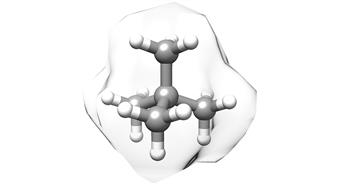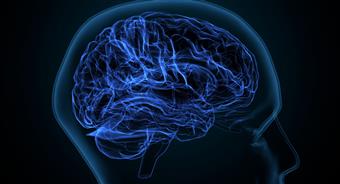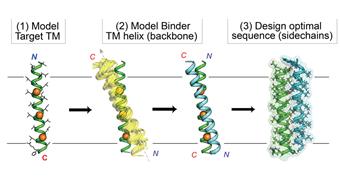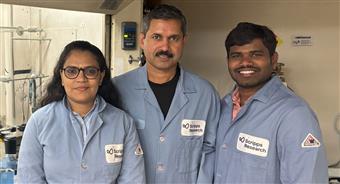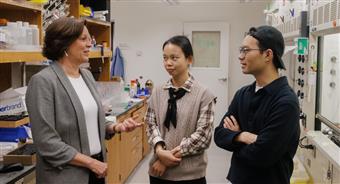
Scientists identify sensor protein that underlies bladder control The protein works in bladder and urinary tract cells to detect bladder fullness; understanding its mechanism may lead to needed treatments.
October 14, 2020
LA JOLLA, CA A team co-led by scientists at Scripps Research has found that the main sensor protein enabling our sense of touch also underlies the feeling of having a full bladder and makes normal bladder function possible.
The discovery, published Oct. 14 in Nature, marks a key advance in basic neurobiology and may also lead to better treatments for bladder control and urination problems, which are common especially among the elderly.
We tend to take urination for granted, and it has been under-studied, yet it's a huge burden when something goes wrong with this system, says the study's lead author Kara Marshall, PhD, a postdoctoral research associate in the Department of Neuroscience at Scripps Research. Now we've identified a crucial part of how urination normally works.
Marshall and her colleagues focused in this study on the PIEZO2 protein, a mechanosensor that detects the physical stretching of tissues where it resides. They found that PIEZO2 is expressed in cells of the bladder and is necessary for normal urinary continence and functioning in both mice and humans.
Who would have imagined that the same mechanosensor protein enabling our sense of touch also alerts us that our bladder is full? says co-senior author Ardem Patapoutian, PhD, Professor and Presidential Endowed Chair in Neurobiology at the Dorris Neuroscience Center at Scripps Research, and a Howard Hughes Medical Institute investigator.
In 2010, Patapoutian and his lab first identified PIEZO2 and its sister protein PIEZO1 as mechanosensors that sense mechanical distortions of tissues. For that feat, among others, Patapoutian was a co-recipient of the prestigious 2020 Kavli Prize in Neuroscience.
Like most sensor proteins, the PIEZOs are ion-channel proteins, which are embedded in their host cell's outer membrane and, when triggered by a stimulus, allow a flow of charged atoms into the cell. Sensor ion-channel proteins are usually found in sensory neurons in the skin, joints and other organs. On a given neuron, when enough of these channels open to admit ion flows, the neuron will fire a nerve signal to the brain.
For PIEZOs, the stimulus that triggers the opening of the ion channel is the stretching of the cell membrane due to mechanical forces on the local tissue. In studies over the past decade, Patapoutian and his colleagues have shown that PIEZO2 is expressed is different organs and tissues throughout the body. For example, they exist in lung tissues to sense lung stretch and help regulate breathing, in blood vessels to sense blood pressure and in the skin to mediate the sense of touch.
The new study was a collaboration with Alexander Chesler, PhD, and Carsten B nnemann, MD, senior investigators at the National Institutes of Health. Chesler and B nnemann, and their colleagues, have been studying people born with genetic mutations that result in the functional loss of PIEZO2. These individuals suffer various impairments in sensory pathways known to be PIEZO2-related.
For the study, NIH investigators found that these PIEZO2-deficient individuals, in addition to their other sensory deficits, lack the normal sense of having a full bladder. They typically urinate on a schedule to avoid incontinence and have trouble completely emptying their bladder when they do urinate.
Patapoutian, Marshall and their colleagues showed in experiments that the loss of PIEZO2 has similar effects in mice. The urinary tract uses PIEZO2 protein in both bladder sensory neurons and in bladder-lining cells called umbrella cells to detect stretch and facilitate urination, indicating a two-part sensor system. As they determined in experiments, bladder neurons in mice normally respond robustly with nerve signals when the bladder is filled but are almost completely silent during bladder filling if they lack PIEZO2.
The mice lacking PIEZO2 in their lower urinary tracts also showed abnormal urination reflexes in the muscles controlling the urethra, the duct in which urine flows from the bladder. That suggests that in mice and most likely in people, the mechanosensor protein is needed both for normal bladder-stretch sensation and for normal urination.
The team is currently following up with research on the distinct roles of bladder neurons and umbrella cells, and how they signal to each other. They are also investigating the possible roles of other mechanosensors, such as PIEZO1, in bladder control and urination.
Mice without PIEZO2 had clear urination deficits, but ultimately were still able to urinate, so that suggests another mechanosensory protein may be involved, Marshall says.
The study, PIEZO2 in sensory neurons and urothelial cells coordinates urination, was authored by Kara Marshall, Adam Coombs, Jason Keller, Ihab Daou, Lisa Stowers, and Ardem Patapoutian of Scripps Research; and Dimah Saade, Nima Ghitani, Marcin Szczot, Tracy Ogata, Carsten B nnemann, and Alexander Chesler of the National Institutes of Health.
Funding was provided by Howard Hughes Medical Institute and the National Institutes of Health (R35 NS105067).
Neuroscience Patapoutian, Ardem
More from Scripps
20/04/2024
New copper-catalyzed C-H activation strategy from Scripps Research Two-mode reactions inspired by human detox enzymes offer powerful new tools for drug discover...
12/04/2024
Scripps Research chemists devise easier new method for making a common type of building block for drugs Scientists transform simple linear amines into saturated...
06/04/2024
A simple, inexpensive way to make carbon atoms bind together A Scripps Research team uncovers a cost-effective method for producing quaternary carbon molecules,...
04/04/2024
Developing a vaccine for the zombie drug xylazine Scripps Research chemical biologists design an early proof-of-concept vaccine that could lead to the first...
30/03/2024
How blocking a neural receptor responsible for addiction could reduce alcohol use A Scripps Research team found that a new therapeutic that targets the kappa op...
13/03/2024
New computational strategy boosts the ability of drug designers to target proteins inside the membrane Customized-design approach could streamline the design of...
29/02/2024
Scripps Research scientists reveal how first cells could have formed on Earth New phospholipid discovery brings researchers closer to understanding how primordi...
29/02/2024
How molecular handedness emerged in early biology Scripps Research chemists fill a major gap in origin-of-life theories.
February 28, 2024
LA JOLLA, CA Mole...
22/02/2024
Snaking toward a universal antivenom Scripps Research scientists discovered antibodies that protect against a host of lethal snake venoms.
February 21, 2024
...
06/02/2024
Calibr-Skaggs announces expansion of option and license agreement with AbbVie to develop novel cell therapies for solid tumors and autoimmune diseases
AbbVie...
26/01/2024
Re-energizing mitochondria to treat Alzheimer's disease Scripps Research team restored neuron-to-neuron connections in human cells.
January 25, 2024
LA JO...
24/01/2024
100 years of Science Changing Life: Scripps Research celebrates a century of transforming human health For the last century, institute leaders and renowned scie...
23/01/2024
New technology lets researchers track brain cells' off switches The method could shed light on what goes awry in numerous brain conditions when neurons ar...
09/01/2024
Three decades of giving: Announcing the Calibr-Skaggs Institute for Innovative Medicines The ALSAM Foundation, founded by the Skaggs family, provides lasting g...
04/01/2024
Life science entrepreneur Gene Lay joins Scripps Research Board of Directors Lay, founder of the global biotech company BioLegend, brings invaluable experience ...
21/12/2023
Taming a plant-derived toxin Scripps Research team modifies the traditional poison picrotoxinin for potential neurological drugs and anti-parasite treatments. ...
19/12/2023
Scripps Research Executive Vice President Eric Topol gives TED talk on transformative power of AI in medicine Topol provides an overview of how AI models can i...
13/12/2023
New AI-powered algorithm could better assess people's risk of common heart condition Early detection of atrial fibrillation can reduce the risk of stroke an...
07/12/2023
Nanoparticle flu vaccine design shows promise in early tests Scripps Research-designed vaccine could provide broad, enduring protection against influenza A str...
16/11/2023
Numerous Scripps Research scientists named Highly Cited Researchers Clarivate's annual, global list represents researchers who have demonstrated significant...
07/11/2023
Multiple sclerosis drug invented at Scripps Research slows long-term devastating disease progression Late-breaking data reinforces the effectiveness and safety ...
05/10/2023
Keren Lasker named a 2023 Moore Inventor Fellow The prestigious award will support Lasker's inventive research in membraneless organelles and their applica...
22/09/2023
Michael Bollong named a 2023 Amgen Young Investigator The prestigious award will support Bollong's research identifying new molecular targets and therapeuti...
09/09/2023
Philip Dawson receives 2024 American Chemical Society National Award Dawson is honored with the Arthur C. Cope Late Careers Scholar Award for his foundational c...
07/09/2023
Scripps Research chemists devise a method for C-H activation of alcohols The method represents a new toolkit for making drugs and other compounds.
September 06...
31/08/2023
Scripps Research receives $1.5M to surveil infectious disease threats in wastewater Bill & Melinda Gates Foundation award to support the development of multi-pa...
16/08/2023
How cold temperatures trigger the brain to boost appetite Scripps Research scientists' discovery could lead to new weight loss and metabolic health treatmen...
08/08/2023
Human antibody that targets carfentanil, fentanyl and related opioids reverses overdose effects in preclinical study Scripps Research-developed antibody therapy...
04/08/2023
How sensory neurons impact the gut Scripps Research scientists show that the receptor PIEZO2 in sensory neurons controls gut motility and transit time, which a...
26/07/2023
AbbVie and Calibr Expand Strategic Collaboration to Advance Several Preclinical and Early-stage Clinical Assets The expanded strategic collaboration will advan...
23/07/2023
Scripps Research scientists develop AI-based tracking and early-warning system for viral pandemics Machine-learning system effectively predicts emergence of pro...
19/07/2023
Monitoring T cells may allow prevention of type 1 diabetes Scripps Research study shows that analyzing T cells in blood samples could be used to select at-risk ...
19/07/2023
Scripps Research mourns passing of leading organic chemist Albert Eschenmoser Eschenmoser pioneered key reactions in synthetic chemistry and shaped the understa...
15/06/2023
Scripps Research awarded $46.8 million by NIH to promote human health through innovative translational science and training The Translational Institute is harne...
13/06/2023
Scripps Research's Danielle Grotjahn named 2023 Pew Scholar in the Biomedical Sciences The award will support Grotjahn's study of how cells assemble the...
31/05/2023
Crossing the ring: new method enables C-H activation across saturated carbocycles Scripps Research chemists add another powerful tool to their molecular editin...
24/05/2023
Scripps Research develops behind-the-scenes tool for better biomedical data discovery The new resource makes datasets more discoverable for life science communi...
19/05/2023
Scripps Research neuroscientist Hollis Cline elected to American Academy of Arts and Sciences Cline is recognized for her discoveries about the role of sensory ...
19/05/2023
Scripps Research's Skaggs Graduate School awards doctoral degrees to 31st graduating class Commencement ceremony will be livestreamed via Zoom and on instit...
13/05/2023
A better route to benzocyclobutenes, sought-after building blocks for drugs Scripps Research chemists devise a new, C-H activation-based method for the synthesi...
09/05/2023
Renowned Scripps Research professor Jeffery Kelly elected to National Academy of Sciences Kelly's groundbreaking work on protein misfolding has led to thera...
28/04/2023
Mirror-image molecules pave new path for cancer drug discovery By comparing how mirror image versions of small molecules impact clusters of proteins, Scripps R...
22/04/2023
How alcohol consumption contributes to chronic pain A Scripps Research team showed how both alcohol intake and alcohol withdrawal can lead to increased pain and...
21/04/2023
Xin Jin receives dual awards to study autism risk genes in neurodevelopment Major grants from the National Institutes of Health and California Institute for Reg...
20/04/2023
Trim the sugar: New HIV vaccine design improves immune response Scripps Research vaccine candidate headed for clinical trials.
April 19, 2023
LA JOLLA, CA A...
18/04/2023
Therapeutic can seek and destroy potent opioid to treat overdoses Scripps Research chemists developed a new biologic to work against the synthetic opioid carfen...
07/03/2023
How heavy alcohol consumption increases brain inflammation The findings by a Scripps Research team point toward a potential new drug target for treating alcohol...
02/03/2023
Scientists find human antibodies that can block multiple coronaviruses including SARS-CoV-2 Results from a Scripps Research and UNC team pave the way for a vacc...
28/02/2023
$10 million grant funds Scripps Research Alcohol Research Center through its 50th year The five-year grant supports research into the neurobiology of alcohol us...
28/02/2023
Immune system drug shows promise in treating alcohol use disorder, a Scripps Research clinical trial reports Scientists at Scripps Research found that apremilas...
 Scientists identify sensor protein that underlies bladder control The protein works in bladder and urinary tract cells to detect bladder fullness; understanding its mechanism may lead to needed treatments.
Scientists identify sensor protein that underlies bladder control The protein works in bladder and urinary tract cells to detect bladder fullness; understanding its mechanism may lead to needed treatments.















